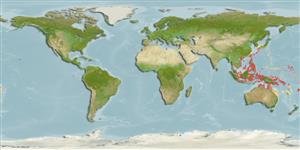>
Gobiiformes (Gobies) >
Gobiidae (Gobies) > Gobiinae
Etymology: Acentrogobius: Greek, a = without + Greek, kentron = sting + Latin gobius = gudgeon (Ref. 45335).
More on author: Herre.
Environment: milieu / climate zone / depth range / distribution range
นิเวศวิทยา
เกี่ยวกับทะเล,น้ำเค็ม; กร่อย สัตว์น้ำหน้าดิน; ระดับความลึก 1 - 4 m (Ref. 90102). Tropical
Western Pacific: Ryukyu Islands, Philippines, Indonesia (Ref. 559) and Papua New Guinea (Ref. 6771).
ขนาด / น้ำหนัก / Age
Maturity: Lm ? range ? - ? cm
Max length : 3.3 cm SL เพศผู้/กระเทย; (Ref. 7050)
เงี่ยงครีบหลัง (รวม): 6 - 7; ก้านครีบอ่อนที่หาง (รวม): 9; เงี่ยงครีบก้น 1; ก้านครีบอ่อนที่ก้น: 9. Characterized by pale grey body color with brown band below eye; gill cover with dark brown streak and blue margin; head and upper half of body with irregular, brown spots and blotches; chain-link pattern at level of upper pectoral fin base to caudal base, composed of five rectangular blotches between two brown stripes, with 2-3 blue spots between each blotch; first three spines of first dorsal usually have filamentous tips; lanceolate caudal fin;, longer than head; longitudinal scale series 28-30; head without scales; ctenoid body scales; depth of body 5.3-5.5 in SL (Ref. 90102).
Inhabits silty sand and mud bottoms, usually near mouth of streams, occasionally near reefs in 1-4 m (Ref. 90102).
Life cycle and mating behavior
วัยเจริญพันธุ์ | การสืบพันธุ์ | การวางไข่ | เซลสืบพันธ์ของเพศเมีย(ไข่) | ความดกของไข่ | ตัวอ่อน
Masuda, H., K. Amaoka, C. Araga, T. Uyeno and T. Yoshino, 1984. The fishes of the Japanese Archipelago. Vol. 1. Tokai University Press, Tokyo, Japan. 437 p. (text). (Ref. 559)
IUCN Red List Status (Ref. 130435)
Warning: mysqli::__construct(): (HY000/1040): Too many connections in /var/www/html/includes/func_getlabel.php on line 46
Can't connect to MySQL database (fbapp). Errorcode: Too many connections
